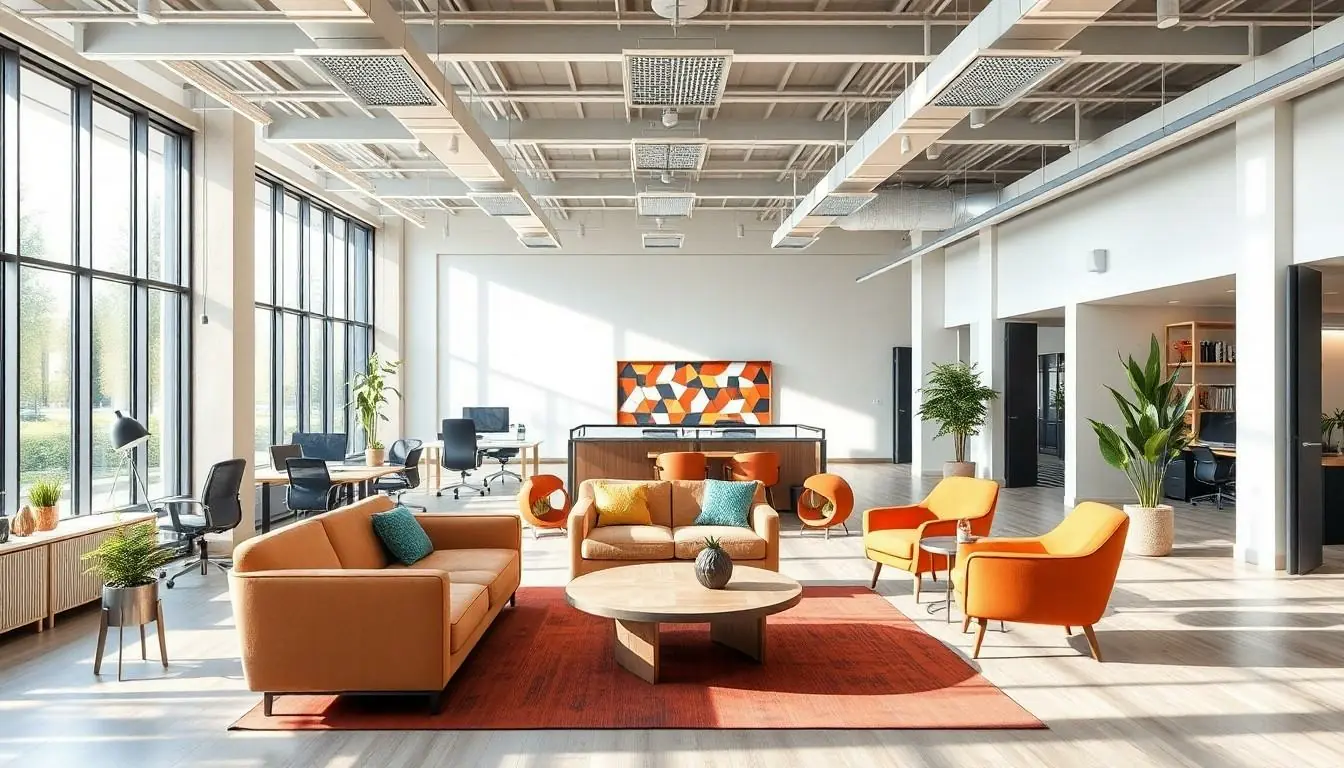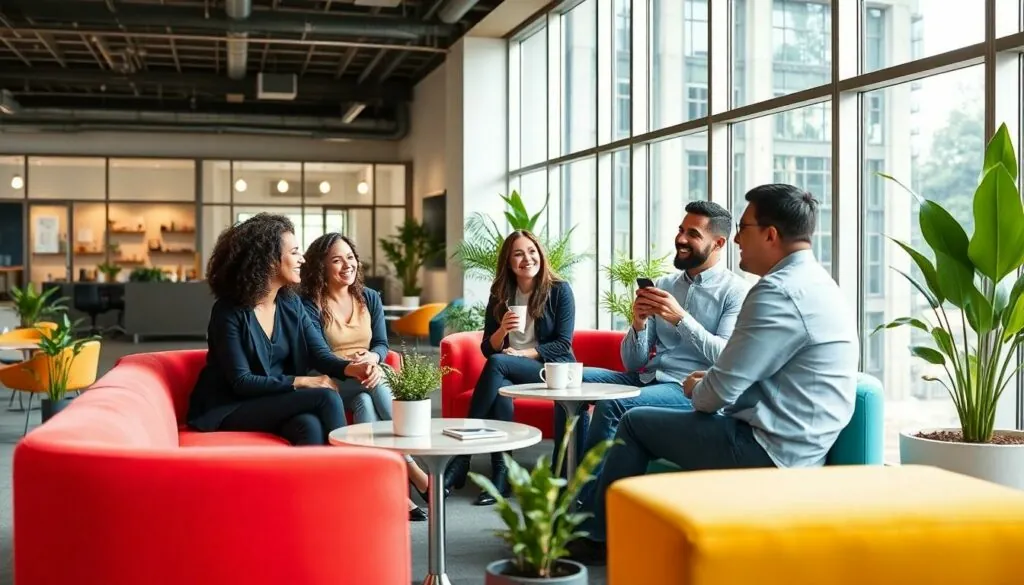In today’s fast-paced business world, a dull office space just won’t cut it. Gone are the days of bland cubicles and flickering fluorescent lights. Companies are now discovering that a well-designed office can boost productivity, spark creativity, and even keep employees from staging a mutiny over the breakroom coffee.
Table of Contents
ToggleOverview of Commercial Office Interior Design
Commercial office interior design focuses on creating functional and aesthetically pleasing workspaces that enhance employee productivity and engagement. Effective design incorporates elements like layout, furniture, lighting, and color schemes, all tailored to support the specific needs of a business.
Various styles exist within commercial office design. Open floor plans encourage collaboration, while private offices provide space for focused work. Break areas promote relaxation, often designed with comfortable seating and vibrant colors to foster creativity during downtime. Biophilic design integrates natural elements, like plants and natural light, to improve employee well-being.
Sustainability plays a significant role in contemporary design. Companies are incorporating eco-friendly materials and energy-efficient lighting, which not only reduce environmental impact but often lead to cost savings over time. Designers increasingly opt for furniture made from recycled materials, contributing to a greener office environment.
Technology integration represents another critical aspect of modern office design. Smart office technology enhances functionality by enabling seamless communication and collaboration among employees. Well-placed power outlets and charging stations also support a connected workspace.
Current trends stress the importance of flexibility in office design. Modular furniture allows for easy reconfiguration as teams grow or change, adapting to various functions without significant investment. Adaptable spaces ensure businesses can respond effectively to evolving work styles.
Overall, commercial office interior design significantly influences organizational culture and employee satisfaction. Thoughtful and innovative design transforms work environments into spaces that inspire productivity and well-being.
Key Elements of Commercial Office Interior Design

Commercial office interior design encompasses various essential elements that enhance functionality and aesthetics. Effective space planning and strategic color choices play significant roles in creating an inspiring work environment.
Space Planning
Space planning involves the strategic arrangement of furniture and workstations to optimize workflow. Efficient layouts facilitate movement, promote collaboration, and support different work styles. Open floor plans encourage teamwork, while designated quiet areas allow for focused tasks. Designers often use zoning to delineate areas such as meeting rooms, lounges, and workspaces. This thoughtful design approach maximizes the use of available space and addresses employee needs, enhancing overall productivity.
Color Schemes and Materials
Color schemes and materials significantly influence the ambiance of an office. Designers often opt for palettes that align with brand identity while promoting a calming atmosphere. Soft neutrals can foster concentration, while vibrant accents stimulate creativity. Selecting sustainable materials complements the growing emphasis on eco-friendliness in design. Choices like reclaimed wood and low-VOC paints contribute to both aesthetic appeal and environmental health. Integrating these elements creates spaces that motivate employees and reflect a company’s values.
Trends in Commercial Office Interior Design
Design trends reflect a shift towards environments that promote well-being and efficiency. Recognizing the changing landscape, companies prioritize elements that enhance both functionality and aesthetics.
Sustainability in Design
Sustainable design practices focus on reducing environmental impact. Designers increasingly incorporate eco-friendly materials, like reclaimed wood and low-VOC paints, into their projects. Energy-efficient lighting solutions also play a vital role in minimizing energy consumption. Brands often benefit from aligning their identity with sustainability; green design appeals to clients and employees alike. Fostering a healthier work environment enhances not only employee satisfaction but overall productivity.
Technology Integration
Technology integration thrives in modern office environments. Smart solutions, such as automated lighting and climate control, create adaptive spaces. Collaboration tools enhance communication among teams, facilitating seamless interactions. Increasingly, offices incorporate soundproofed areas for focused work, balancing open spaces with privacy. Designers consider technology’s role early in the planning stages, ensuring workspaces meet evolving needs. These advancements contribute to a connected and engaged workforce, driving business success.
Benefits of Effective Commercial Office Interior Design
Effective commercial office interior design significantly enhances workplace dynamics. Thoughtful design fosters employee engagement and satisfaction.
Improved Employee Productivity
Enhanced productivity often results from intentional workspace design. Well-structured layouts allow seamless collaboration and focus on individual tasks. For instance, private areas for concentrated work minimize distractions, while open spaces promote teamwork. Research indicates that employees in well-designed environments experience a 15% increase in productivity. Furthermore, ergonomic furniture supports comfort and reduces fatigue, enabling employees to perform optimally throughout the workday. Effective lighting also contributes, as natural light and adjustable fixtures improve mood and energy levels. Ultimately, a carefully designed workspace creates an environment where employees thrive.
Enhanced Brand Image
Strong brand image emerges from a well-designed office space. Interior design reflects a company’s values and culture, making a lasting impression on clients and visitors. Design elements such as color schemes and furniture styles should align with brand identity, conveying professionalism and creativity. For example, a tech startup may incorporate modern finishes and vibrant colors, while a law firm might opt for classic styles and muted tones. A visually appealing office attracts top talent and showcases commitment to employee well-being. Effective design also strengthens team unity, as shared spaces encourage interaction and collaboration, further enhancing brand perception.
The evolution of commercial office interior design reflects a shift towards creating spaces that prioritize employee well-being and productivity. By focusing on elements like layout, lighting, and sustainability, businesses can craft environments that not only enhance workflow but also resonate with their brand identity.
Incorporating smart technology and flexible designs ensures that workspaces can adapt to the changing needs of teams. As companies invest in thoughtful design, they pave the way for a more engaged workforce, ultimately leading to increased productivity and satisfaction. Embracing these principles is essential for any organization looking to thrive in today’s competitive landscape.




